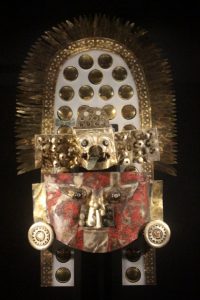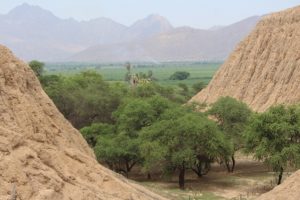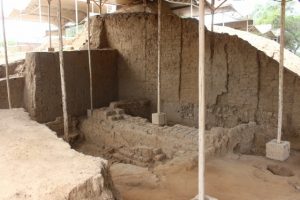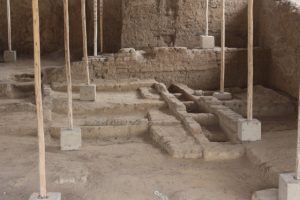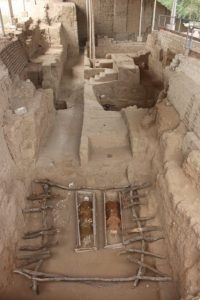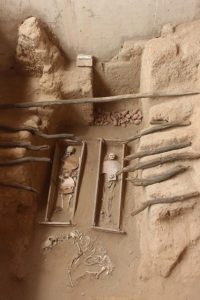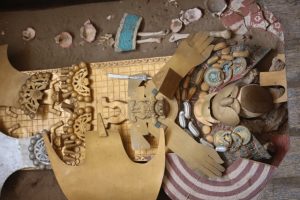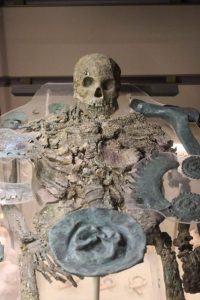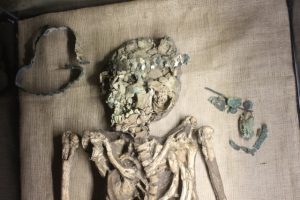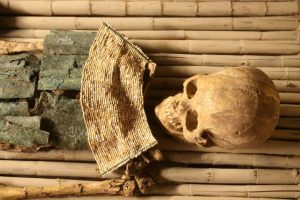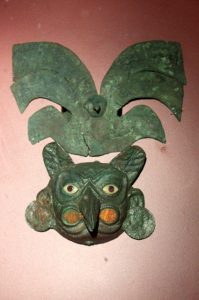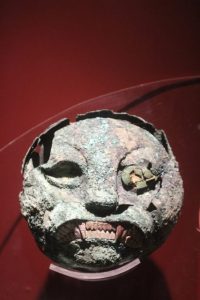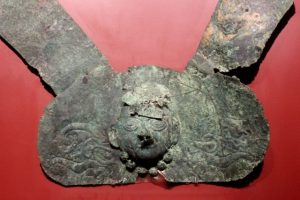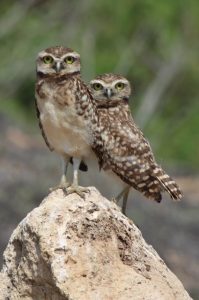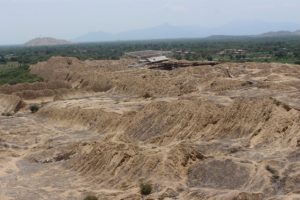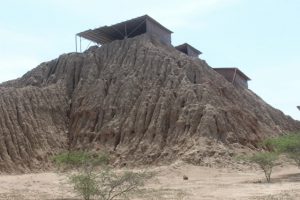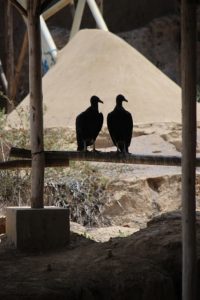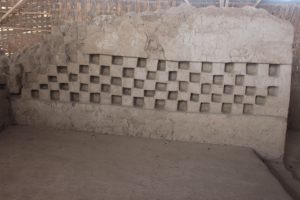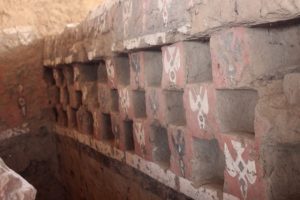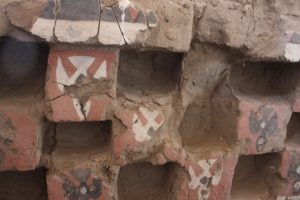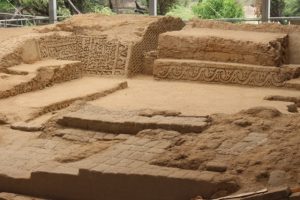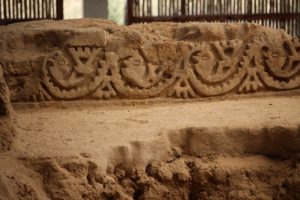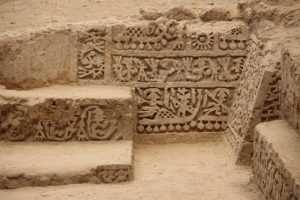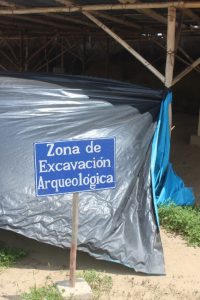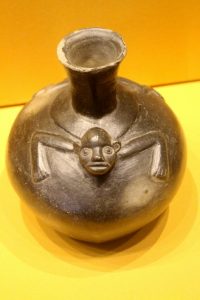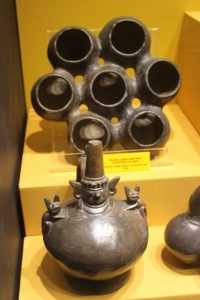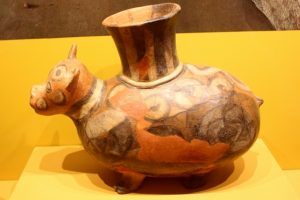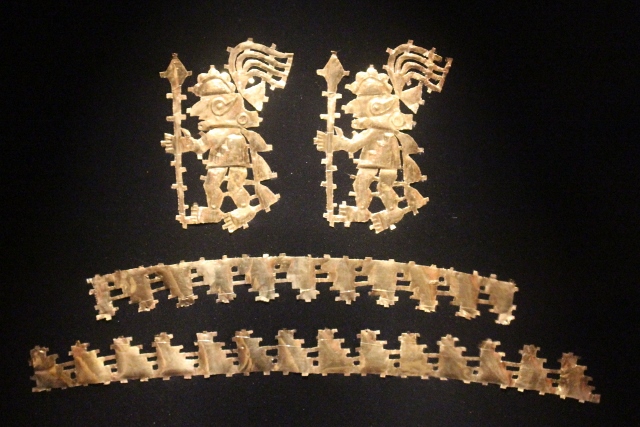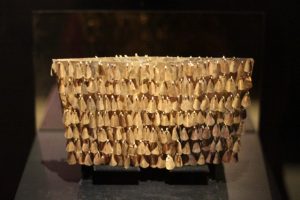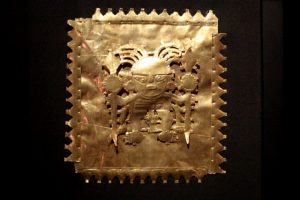Outside Chiclayo are many remains of ancient, pre-Inca Peruvian cultures, who built earthen pyramids where they burried their elite, together with fabulous treasures, now to be admired in equally fabulous museums.
Some of the most exciting locations that demonstrate Northern Peruvian pre-Inca civilizations can be found around Chiclayo. The oldest are the Moche, which existed roughly from 200 BC to 850 AD. The main Moche sites are near Trujillo, where we will get to later, but perhaps the most evocative one is burial site of Sipan, just south of Chiclayo.
Grave robbers have been pretty effective everywhere in Peru, having caused unimaginable damage to archaeological sites, yet, the tombs at Huaca Rayada, near the village of Sipan, have miraculously been saved from this form of vandalism. Until 1987. Early that year a local archaeologist noticed an incredible influx of intricate gold and silver objects on the black market, and he immediately realised that a major tomb had been discovered and was being ransacked. The man managed, through carefully questioning the sellers, to identify the location of the tomb near Sipan. Swift protection stopped further looting, but not before several battles with the locals – who saw the tombs as their rightful source of income for the time to come. Their resistance was broken by offering them training and jobs as excavators and guards, creating stable employment, especially because the most important tombs had not yet been discovered. In the early 90’s several major finds were made, the most exquisite being the tomb of what became known as El Senor de Sipan (the Lord of Sipan). Loads of gold, silver and arsenic copper objects have been recovered, alongside the disintegrated mummies of not only the Senor, but also several wives, children and guards, and hoards of pottery. After all, the Senor went to his next life, so had to be provided with everything he could possibly need.
On the site itself, it becomes clear why these tombs have been protected for so long. The Moche built pyramids, by stacking thousands of adobe bricks to a height of perhaps 25-30 meters. But rain – many of these cultures, including the Moche, went in decline after torrential rains caused by climate effects like El Nino – has reduced these pyramids to heavily eroded earthen hills, hardly recognisable as ancient structure.
The tombs are on one side, deep inside one of the pyramids. Rather than showing empty holes, the graves have been recreated inside the holes, to give an idea of the original contents of the tombs. Which has been done very nicely, and very tastefully – if that is the right word to be used here. A small museum shows artefacts and mummies that have been found in some of the lesser tombs, and this, too, has been done very tastefully.
But the main items, those of the tomb of the Senor, as well as those of several other important tombs, have been brought together in a museum in the small town of Lambayeque, the Museo Tumbas Reales de Sipan. This museum in itself is already worthwhile coming all the way to Northern Peru. It shows the headdresses, the pectoral plates, a solid golden crown, jewellery, and lots more, very well presented, and very well lit. But what it also does is showing photographs of where the objects were found, and – even more interesting – how they were found, in what state. The pictures are presented next to the object, which has been cleaned, restored, and whatever else has been done to it, almost beyond recognition compared to the photographs. In this way the museum has become much more than a showcase of antiquities, it is a demonstration of the workings of archaeology, from find to final presentation. Most unfortunately, one is not allowed to take pictures inside – not even my sneaky ones were possible, as we needed to leave backpacks, bags, and mobile phones behind. So we are left with the memory only, and the few pictures from the onsite museum in Sipan.
The successor culture to the Moche were the Sican – very similar to the name Sipan, but much younger, from around 750-1375 AD. They too, built adobe pyramids, of which a huge complex, no less than 26 of them, is left near the village of Tucume, 30 km from Chiclayo. And these, too, have mostly crumbled into earthen humps, heavily eroded – the Sican culture also came to an end after a bad case of El Nino. But the erosion continues to present day, apparently, with major floodings causing further damage two years ago. So many of the pyramids, partly excavated, were closed – although with a bit of ingenuity we managed to admire some of them a little more close-up, anyhow.
The nicest one, the Huaca Las Balsas, which was open to the public, we left for the end. And it was worth the struggle through the barren site, shade-less and hot. This pyramid, the best preserved, or at least the one most excavated, shows lots of little detail in decoration, from geometric patterns to scenes with people and animals. But many of the ongoing excavations around the pyramid were off limits, and with plenty of guards here, even our ingenuity didn’t help in exploring these further.
Another Sican site, Batan Grande, was just too difficult to get too – and in any case, there are only so many mud humps you can admire. But results of excavations there have been presented in a small museum in the town of Ferrenafe, much closer to Chiclayo. Once more very well displayed, the Museo Nacional Sican shows the contents of a couple of burial tombs: decorative objects, pottery and some fabulous jewellery, as well as one of the best masques I have ever seen.
All together a great combination of on site tasting the real thing in the coastal heat, and admiring the exquisite artefacts in the comfort of air-conditioned museums. Archaeology the way I like it most.
next: to Chachapoyas, in the Amazonas region
